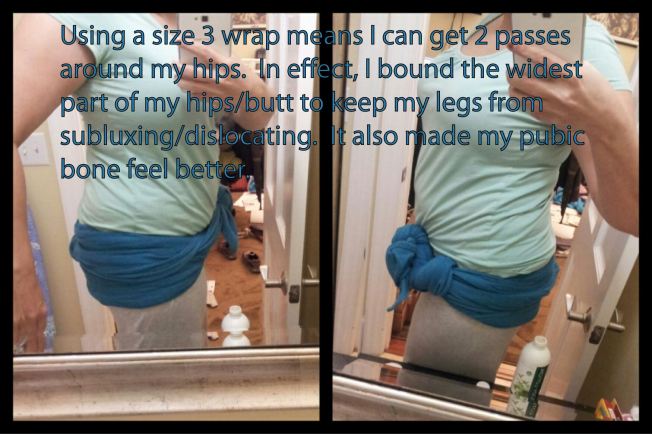
Almost all of my joints are hypermobile
I meet more and more people with joint hypermobility these days. I suppose that should be a good thing for me, and it is nice to have the feeling that I’m not alone. I just wish the medical professionals would learn more about it. Funny enough, I’ve met more vets and vet students who are aware of the syndrome than people doctors. I remember being 7 years old and having excruciating pain in my legs and knees. My parents were rightfully worried and took me to the ER. I don’t remember whether I had an x-ray or not but I do remember the doctor telling my parents that they were just growing pains and they’d go away soon. When I was in 8th grade, I ran track and loved it. I had to quit because I had such knee pain 2 days after running at meets. I didn’t practice for the same reason. I decided in high school to become a cheerleader and although all the other girls practiced their acrobatic moves like splits, scorpions, etc., I never did. I just popped in and out of those positions. Lest this sound like bragging, I’m really kicking myself for participating in sports that probably at the least didn’t help my hypermobility but it’s possible I started causing myself long term problems by making my joints more mobile than they would have been. I also always had jaw pain and dentists wrote it off as “TMJ” (actually, that is the name of the joint so we all “have” TMJ- LOL). In college and after graduation, I had increasing jaw pain to the point where my jaw locked several times. That was very scary. As an adult, I’ve had increasing pain to the point that I’ve been bounced around multiple orthopedists, a rheumatologist, oral surgeon, and pain clinics. I’ve found relief with chiropractors, acupuncture and massage combined with pain medication and reduced activity. Unfortunately, since I move around less, I am overweight. Bummer.
I wanted to write about my experiences for others that suspect they have hypermobility and just tell them it’s a daily struggle but there are options out there. You’ll probably run into a lot of doctors who look at an x-ray and MRI and declare that there is no reason to be in pain (that was fun) but when they finally find some answers, they can get to a steady state.
So, I thought I would describe the syndrome and add in my own details as well. It’s kind of weird how many things are affected when your collagen is faulty.
Ehlers-Danlos Syndrome is a heterogeneous group of heritable connective tissue disorders that, in some cases, can be life-threatening. The different types of EDS are classified according to the signs and symptoms that are manifested. For each type of EDS, the diagnostic criteria, hereditary patterns and management can differ.
Excerpted from Genereviews, a peer reviewed journal with free articles. The article describing Ehlers-Danlos Type 3 is authored by Howard P Levy, MD, PhD.
Disease characteristics. Ehlers-Danlos syndrome (EDS), hypermobility type is generally considered the least severe type of EDS, although significant complications, primarily musculoskeletal, can and do occur. The skin is often soft or velvety and may be mildly hyperextensible. Subluxations and dislocations are common; they may occur spontaneously or with minimal trauma and can be acutely painful. Degenerative joint disease is common. Chronic pain, distinct from that associated with acute dislocations, is a serious complication of the condition and can be both physically and psychologically disabling. Easy bruising is common. Functional bowel disorders are likely underrecognized. Autonomic dysfunction, such as orthostatic intolerance, may also be seen. Aortic root dilation is typically of a mild degree with no increased risk of dissection in the absence of significant dilation. Psychological dysfunction, psychosocial impairment, and emotional problems are common.
Major diagnostic criteria should all be met to establish a diagnosis of EDS, hypermobility type:
- Joint hypermobility, which is often confirmed by a score of five or more on the nine-point Beighton scale [Beighton et al 1973], although some individuals with objective joint laxity score fewer than five points
- Soft skin with normal or only slightly increased extensibility
- Spontaneous or easily induced skin cuts or tears
Minor diagnostic criteria are supportive of but not sufficient to establish a diagnosis of EDS, hypermobility type:
- Positive family history of EDS, hypermobility type (or family history of joint laxity), without significant skin or soft tissue fragility, in a pattern consistent with autosomal dominant inheritance
- Recurrent joint dislocations or subluxations
- Easy bruising
- Functional bowel disorders (functional gastritis, irritable bowel syndrome)
- Neurally mediated hypotension or postural orthostatic tachycardia
- High, narrow palate
- Dental crowding
Basically, I have all but the bowel disorders, tachycardia, and high palate. Weird huh?
Here’s some more information for you about Ehlers-Danlos, which includes other types that are fatal. Types 1 and 2 are the classical form, type 4 is the vascular form, and there seem to be several other types not well described. The Ehlers-Danlos Foundation has flyers for parents whose children may have EDS. EDNF is a great resource and I should spend some more time reading there myself. They do annual conferences with knowledgable scientists and doctors. I would love to attend sometime.





